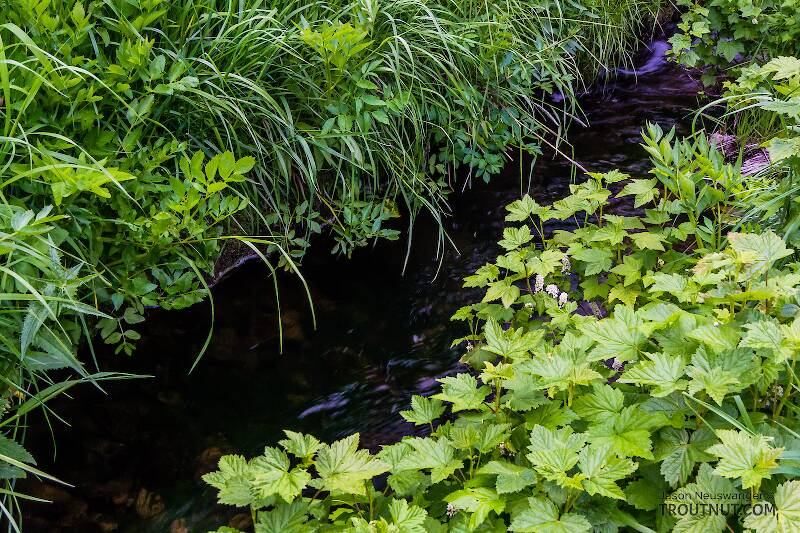
Salmonflies
Pteronarcys californica
The giant Salmonflies of the Western mountains are legendary for their proclivity to elicit consistent dry-fly action and ferocious strikes.


Mayfly Species Plauditus punctiventris (Tiny Western Olives)
Where & when
Time of year : Late June and early July; again in late September and early October
Preferred waters: Spring creeks
In 8 records from GBIF, adults of this species have been collected during May (38%), July (25%), June (25%), and April (13%).
In 5 records from GBIF, this species has been collected at elevations ranging from 618 to 6270 ft, with an average (median) of 5249 ft.
Species Range
Nymph biology
Substrate: Gravel, vegetation
Physical description
Most physical descriptions on Troutnut are direct or slightly edited quotes from the original scientific sources describing or updating the species, although there may be errors in copying them to this website. Such descriptions aren't always definitive, because species often turn out to be more variable than the original describers observed. In some cases, only a single specimen was described! However, they are useful starting points.
Nymph
A pale nymph which in life is bright chlorophyll green.
Head: Head and mouth parts pale and of typical Pseudocloeon form; antennae pale, reaching back to about middle of mesothorax.
Thorax: In general pale with some light greenish dorsal maculation; legs pale and immaculate; tarsal claws pectinate at base.
Abdomen: Dorsal maculation of pale marks on a light greenish background; an indistinct pale median band and pale lateral flanges; a pair of slightly darkened dots in the middle of each segment forming submedian rows and in front of these darkened indistinct dashes converging on the anterior border; ventrally a median row of small jet black dots the latter situated about the middle of the segment in the anterior of segments (sometimes these present in only two or three anterior segments and entirely absent in occasional individuals); these dots persist in the adult; lateral caudal filaments with a dark bar about halfway out; median filament relatively long for a Pseudocloeon measuring in length about twice the width of a lateral filament at the base and composed of several segments; gills relatively clear without conspicuous tracheae; these may be somewhat more prominent in fresh material.
Male Spinner
Wing length: 4-4.5 mm
Abdominal tergites 2-6 of male imago whitish hyaline; a mid-ventral row of minute dots on posterior margins of sternites.
Turbinate eyes almost circular, larger than in P. dubium (now a synonym of Plauditus dubius); light yellow-brown, stalk paler, with a purplish brown ring just above the base. Face blackish, antennae and base of ocelli tinged with pale yellowish green. Antennae black, the tips paler; pale ring at apex of first joint. Thorax blackish, shaded laterally with pale olive; slight greenish markings on anterior portion of mesonotum, its lateral margin, and on the scutellum; metanotal projection marked with greenish. Legs whitish; fore femur usually with smoky tinge. Wings hyaline. Abdominal segments 2-6 whitish hyaline; faint black dots over each spiracle. Tergites 7-10 light brown, ruddier than in P. dubium; sternites opaque white. On the posterior margin of each sternite, at the midventral line, is a minute dot.
The lack of submedian red dots on tergites 2-6 and the paler apical tergites separates this species from P. virile (now a synonym of Plauditus virilis); the absence of red patches on the tergites distinguishes it from P. rubrolaterale (now a synonym of Iswaeon rubrolaterale); while the presence of mid-ventral dots sets it apart from P. dubium.
Start a Discussion of Plauditus punctiventris
References
- Arbona, Fred Jr. 1989. Mayflies, the Angler, and the Trout. Nick Lyons Books.
- Caucci, Al and Nastasi, Bob. 2004. Hatches II. The Lyons Press.
- Ide, F. P. 1937. Descriptions of Eastern North American Species Of Baetine Mayflies with Particular Reference to the Nymphal Stages. The Canadian Entomologist 69(11): 235-243.
- Needham, James G., Jay R. Traver, and Yin-Chi Hsu. 1935. The Biology of Mayflies. Comstock Publishing Company, Inc.
- Swisher, Doug and Carl Richards. 2000. Selective Trout. The Lyons Press.
Mayfly Species Plauditus punctiventris (Tiny Western Olives)
Species Range
Common Names
Resources
- NatureServe
- Integrated Taxonomic Information System
- Global Biodiversity Information Facility
- Described by McDunnough (1923)

